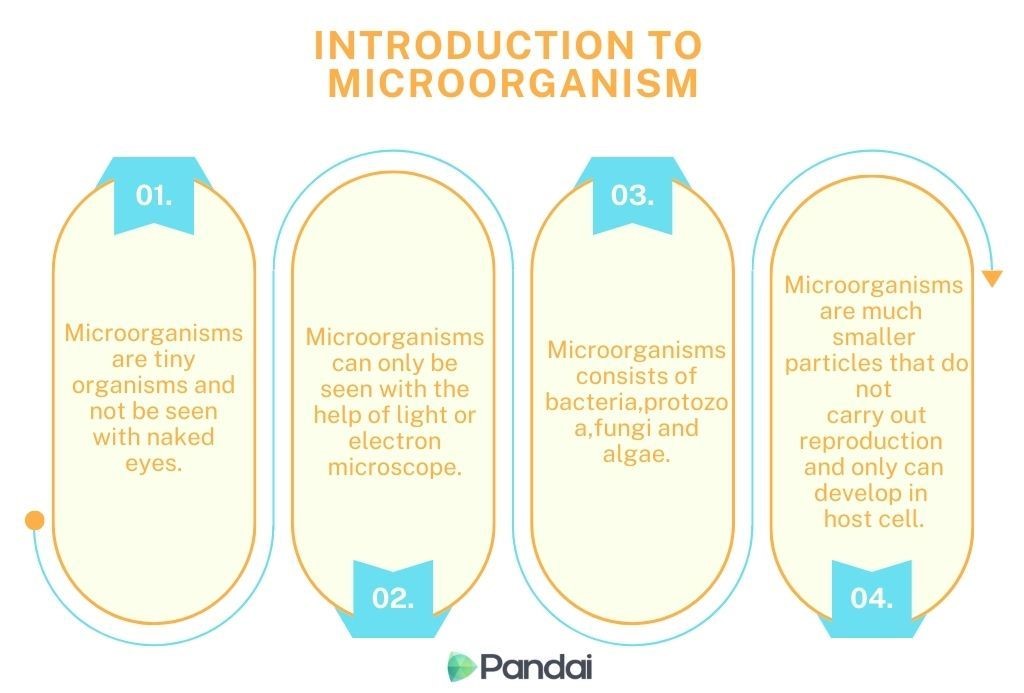| |
| 8.3 |
Microorganisms and Viruses |
|
| |
 |
| |
| The Main Characteristics of Microorganisms and Viruses |
- Unicellular organisms.
- Have cell wall, plasma membrane and DNA which is not enclosed by a nuclear membrane.
- Are heterotrophs or autotrophs.
- Reproduced by binary fission and conjugation.
- Form spores under unfavourable condition.
- Examples: Escherichia sp coli., Lactobacillus sp.
|
- Unicellular organisms.
- Live in aquatic.
- Have plasma membrane, nucleus and other membranous organelles.
- Heterotrophs organisms.
- Use cilia, pseudopodium and flagellum to move around.
- Reproduce sexually or asexually.
- Examples: Paramecium sp., Ameoba sp. and Plasmodium sp.
|
- Unicellular organisms, non-fillamentaous and multicellular organisms.
- Able to carry out photosynthesis as they have chloroplast.
- The cell wall is made up of glycoprotein.
- Do not have stems, leaves and roots.
- Reproduce sexually or asexually.
- Examples: Chlamydomonas sp. and Spirogyra sp.
|
- Unicellular organisms and multicellular organisms.
- Has no chlorophyll.
- Saprophytic or parasitic organisms.
- Secrete extracellular enzymes to breakdown organic matter before they are absorbed.
- Reproduce by binding or formation of spores.
- Examples: Yeast, Mucor sp.
|
- Not microorganisms
- The smallest size.
- Can only be seen under an electron microscope.
- Only consists of DNA or RNA covered by a protein coat.
- Cannot reproduce outside the host cells.
- All are parasites.
- Can be crystallised outside host cells.
- Examples: Bacteriophage, influenza virus and HIV.
|
|
| |
| The Role of Microorganisms |
| Microorganisms as Producers |
- Provide nutrients to primary consumers.
- Main energy source in a food chain.
- Examples:
- Cyanobacteria.
- Phytoplankton (algae).
|
| Microorganisms as Decomposers |
- Decompose organic materials to reduce pollution by preventing accumulation of the organic waste remains.
- Return nutrients to soil.
- Examples:
- Saprophytic bacteria.
- Fungi.
|
| Microorganism as Symbionts |
- Tryconympha sp. in a alimentary canal of termites secretes cellulase to digest carbohydrate into glucose to be absorbed by the termites.
- Human colon has symbiotic bacteria which syntheis vitamin B and vitamin K.
- Examples:
- Tryconympha sp. (protozoa)
- Lactobacillus sp.
|
| Microorganisms as Parasites |
- As predator to form a balanced food chains.
- Also as prey for other consumers.
- Examples:
|
|
| |
| Pathogens |
- Definition: An organism which causes diseases.
- For example:
- Viruses.
- Bacteria.
- Protozoa.
- Fungi.
|
|
| |
| Vectors |
- Definisi: An organisms which transmit pathogens and cause certain diseases.
- Contoh:
- Mosquito.
- Flies.
- Cockroaches.
- Infected wild animals.
|
|
| |
| The Effects of Pathogens on Human Health |
- Pathogens disrupt the immunity system in many ways.
- Viruses or bacteria cause sickness when they disturb cell functions or cause cell damage.
- Some pathogens release toxins that could lead to paralysis or destroy metabolic activities in the body.
- The table below shows the symptoms of disease caused by pathogens:
| Pathogen |
Example of Disease |
Symptoms of Disease |
| Virus - Human papillomavirus (HPV) |
- Sexually transmitted disease.
- Cervix cancer.
- Other cancer
|
- Warts on hand, leg, face and genital organ.
- Irregular blood spotting after periods.
- Prolonged and more menstruation than normal.
- Postmenopausal bleeding.
- Increased vaginal discharge.
|
| Bacteria - Salmonella sp. |
|
- Vomitting.
- Diarrhea.
- Abdominal cramps.
- Headcahe.
|
| Protozoa - Plasmodium sp. |
|
- Shrivel is followed by headache.
- Skin becomes yellowish.
- Anaemia.
|
| Fungi - Tinea sp. |
|
- An erythematous patch with slightly scaly and small erythematous popules present at its periphery.
- The patch will enlarge and with the presence of its central clearing, it will appear ring-like or annular.
|
|
|
| |